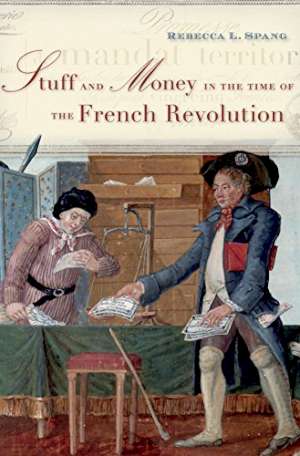11 July 2017
Stuff and money in the time of the French Revolution
Rebecca L Spang
2015, Harvard University Press, 350 pages,
ISBN 0674047036
Reviewer: William A Allen

Rebecca Spang’s account of the financial aspects of the French Revolution draws attention to several under-appreciated facts. For one thing, the objectives of the revolutionaries were in important respects what would now be called neo-liberal. They attached immense importance to economic freedom, notably freedom of contract, and to repayment of state debts, even those debts whose legitimacy was doubtful. And for another, money played a very important part in the history of the revolution.
The main innovation of revolutionary monetary policy was the assignats. These were debt instruments issued by the government, which were supposed to be redeemed out of the eventual sale proceeds of Church land and property which the revolutionaries had seized. They metamorphosed into money in 1792, when France declared war on Prussia and Austria, and the amount issued ceased to bear any particular relationship to the amount of land and property at the state’s disposal. As Spang says (p. 104), “This was the first time that the state endeavored to control the amount of currency being printed (or minted), the first time that the state exercised a monopoly over the raw materials from which money was made.”
Assignats were issued in large denominations, but there was a serious and enduring shortage of small-denomination currency, which was partly responsible for the depreciation in value of the assignats. Smaller-denomination notes were introduced, but there were severe limits on the speed with which they could be printed. Spang provides a lot of interesting information on the consequences of the dearth of small-denomination currency, which demonstrates beyond any possible doubt that a successful monetary policy has to ensure adequate access to efficient systems for making payments of modest size.
Spang’s account of the hyperinflation of 1794-96, which remarkably does not include any tables or figures, picks an unnecessary fight with the quantity theory of money, and with economics more generally. One may regard the quantity theory as over-simple in most situations, but it is fairly reliable in hyperinflations. Spang however attacks the quantity theory interpretation that over-issue of assignats caused prices to explode:
‘…the dramatic price increases of the 1790s actually began before most of the assignats had been issued. In other words, the case of the assignats does not so much substantiate the quantity theory of money as it reverses it: because prices rose in autumn 1794, the government had to issue more paper to cover its costs. Money responded to prices, not prices to money.’ (p 216).
This passage, however, is an explanation of why so many assignats were issued, not a denial that they were actually issued. And there are plenty of reasons why prices might have risen ahead of the issue of assignats. A much clearer, more persuasive and more concise explanation of the hyperinflation, and other financial aspects of the revolution, is provided in a paper by Thomas Sargent and Francois Velde, to which Spang does not refer.
Spang is on much firmer ground when she says (p 217) that, “…[E]ach episode of hyperinflation needs to be addressed on its own terms, as an economic manifestation of a specific political and social crisis.” Hyperinflations do not happen unless a lot of money is issued – that is the core of truth in the quantity theory – but a lot of money is not issued unless there is something else badly wrong. And she is surely right to conclude (p 277) that, “Economic policy decisions are also, inevitably, political choices – choices that have uneven effects and, very often, unintended outcomes.”
Spang’s account is accompanied by extensive methodological commentary which might test the endurance and the comprehension of those who just want to know what happened during the French Revolution. Such readers would be well advised to begin with Sargent and Velde, and turn to Spang later for a bit more colour.
‘Macroeconomic features of the French Revolution’, Journal of Political Economy, June 1995, pp 474 – 518.
